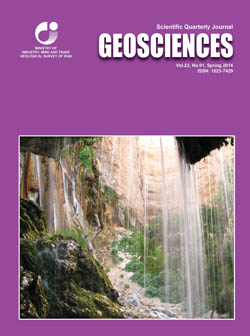Document Type : Original Research Paper
Authors
1 Ph.D., Geological Survey and Mineral Explorations of Iran, Tehran, Iran
2 Associate Professor, Department of Geology, Faculty of Basic Sciences, Tarbiat Modares University, Tehran, Iran
Abstract
The North Esfajerd ductile shear zone is exposed in NE Golpaygan in the Sanandaj-Sirjan zone. The shear sense indicators are observed in the both outcrop and microscopic scales in this shear zone. These indicators are representing a NW striking dextral shear. The dynamic analysis and outcrop- scale indicators of extension direction exhibit a NW extension sub-parallel to the dextral shear and a compression perpendicular to it. The relative simultaneity and parallelism between North Esfajerd ductile shear zone and North Varzaneh thrust shear zone propose the partitioning of strain components in a transpressional deformation. Regarding the geochronologic data and the angular unconformity between the middle Cretaceous and Eocene rock units, the transpressional deformation and its related mylonitization occurred during the Laramide orogeny in late Cretaceous-Paleocene. The gently dipping mylonitic foliations with dextral shear imply an incompatibility between geometry and kinematics in the North Esfajerd ductile shear zone. However, the kinematic and dynamic characteristics of the North Esfajerd ductile shear zone are accommodated with lateral extrusion of material in a dextral domain.
Parallelism between the trends of dominant stretching lineations and the second generation large scale fold axes document that the major mylonitization in the North Esfajerd shear zone occurred during the second generation deformation. These mylonitic fabrics were folded due to the third generation deformation. Two generations of crenulation cleavages, respectively in relation to two refolding events, can be recognized in this shear zone. One of the refolding events with type III interference patterns (coaxial refolding) occurred during the second stage deformation in the late Cretaceous- Paleocene interval, caused the formation of the North Esfajerd shear zone, and can be observed in an outcrop scale. The other has emerged during the third stage of deformation, probably in the post Paleocene-pre Miocene interval, folded the North Esfajerd shear zone and formed the type II (boomerang shape) interference pattern in a map scale.
Keywords

